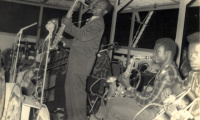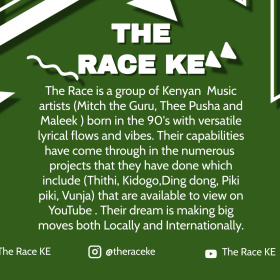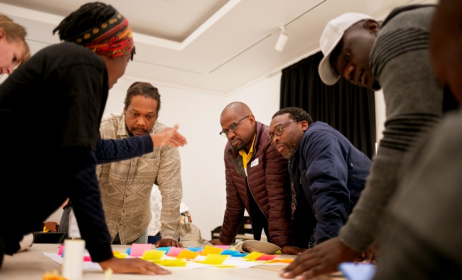Traditional music in Mozambique
This article provides an overview of traditional music in Mozambique, focusing on the genres of marrabenta, timbila, nyau and mapiko.
 Mozambican ensemble Timbila Muzimba. Photo: Flickr
Mozambican ensemble Timbila Muzimba. Photo: Flickr
Historical background
Mozambique gained independence from Portuguese rule on 25 June 1975. Since then, a number of measures have been taken by the governing Mozambique Liberation Front (FRELIMO) to resume indigenous cultural activities in the southern African country. After independence, the new leadership saw culture as an important tool for nation-building – a strategy employed by post-colonial governments across various countries on the African continent in an attempt to regain their respective identities.
In Mozambique, the implementation of traditional practices after independence was “natural”, given that colonial policies were developed to repress local culture[1]. Such policies forbade Mozambicans to speak their native language, practice their own religion, or play their own music.
In 1978 the inaugural edition of the National Festival of Popular Dance was held in the capital Maputo in the presence of Samora Machel, the first president of independent Mozambique. Machel’s attendance was politically important because it signalled that the revival of local culture would play a vital part in the nation-building process. The National Festival of Popular Dance has been maintained by the FRELIMO government to this day[2].
The terminology used to define Mozambican arts was also reformed by FRELIMO. The term ‘traditional’ began to be used in the post-Independence era, as opposed to the colonial moniker of ‘folklore’. Among traditional Mozambican music, we can distinguish the genres of marrabenta, timbila, mapiko and nyau.
Marrabenta
Marrabenta is an urban musical genre that emerged in the 1930s[3]. It is based on a mixture of Portuguese folk sounds and traditional southern Mozambican rhythms such as zucuta, magika and n’fena. It became prominent in the suburban areas of Maputo (known as Lourenço Marques until 1976), where a black majority resided, though the city saw a mixture different ethnicities.
In particular, Maputo’s suburb of Mafalala was well-known for its cultural dynamism, being the home of famous figures such as the poet José Craveirinha, footballer Eusebio, Samora Machel and the world's first African bullfighter, Ricardo Chibanga. Mafalala was a nightlife hotspot where the Comoreanos nightclub was located in the 1940s and 1950s. According to Craveirinha and other writers at the time, marrabenta originated at the Comoreanos[4]. The club, which was owned by an association headed by expats from the Comoros Islands, played host to North and South American sailors who were in transit in Lourenço Marques.
Marrabenta began to gain widespread popularity in the 1960s when liberation movements such as FRELIMO disrupted the Portuguese colonial structure. Conflicts in the region, which eventually led to the Mozambican War of Independence (1964-1974), gave rise to moderate politicians like Adriano Moreira, who became Portugal’s Minister of the Overseas Provinces. Moreira abolished the Indigeneity Statute and introduced integrationist policies that defended equal rights and allowed black Mozambicans to obtain Portuguese citizenship[5].
This popularised marrabenta music even further. For instance, the Africa à Noite radio show played Mozambican musicians such as Orquestra Djambu and João Domingos, and marrabenta was broadcast alongside established Portuguese genres such as fado and vira[6].
Timbila
The word timbila in the Chopi language comes from the wooden xylophone of the same name (singular: mbila). These instruments are constructed from wooden slats each fitted with a resonating calabash, which is then sealed with beeswax. The result is an energetic, bright and buzzing sound as the slats are beaten, polyrhythmically, with mallets.
According to researcher Marilio Wane, the musical tradition of timbila is a combination of music, dance and oral literature[7]. The musical and choreographic arrangements that constitute timbila are known as ngodo (structure). A timbila composition has a number of movements, namely mtsitso (the instrumental introduction), xithokhozelo (declamation), mwemisso (break), chibhudhué (drama), mzeno (singing) and mtsitso ho guita (closing/conclusion). The songs and performances usually express commentary about social issues, or else chronicle important events in the life of the community.
Timbila comprises an ensemble of musicians and dancers – as many as two dozen – under the guidance of a conductor. Timbila performances happen at weddings and other important community events, while the M'saho Festival, held annually in the southern district of Zavala, is an annual showcase for the genre[8].
Mapiko
Mapiko is a Mozambican traditional dance that is accompanied by drums of the same name. The dance was originally performed by the Makonde people in northern Mozambique, but found its way to other parts of the country when freedom fighters began using its theatrics as part of their doctrine[9]. Etymologically, the word mapiko is linked to the verb kupika, which alludes to the transformation of a sorcerer into a magical beast. In musical terms, mapiko refers to a masquerade performance where a dancer is covered in a large cloth while wearing a wooden headpiece, although some mapiko rituals do not involve a headdress. Mapiko is at the heart of initiation rituals, as well as other important ceremonies, where the masked dancer is the symbol of the occasion[10].
Nyau
The word nyau means ‘mask’, and is primarily used to refer to a secret society of the Chewa people of central and southern Africa[11]. However, the word nyau is not only used for the society itself, but also for the hierarchy of the people who form this society, the ritual dances associated with it, and the unique masks used in these dance performances.
The spirit world – a central feature of Nyau cosmology – is symbolised by the Gule Wamkulu (Big Dance), a cultural practice that incorporates mwambo (traditions) such as masks, songs and dances, and is usually performed at funerals, memorial services and initiation rituals. Each dancer represents a unique character depending on the mask or zoomorphic costume that he wears. The zilombo, for example, are large constructions that cover the entire body and which mostly represent animals, while the masks worn over the face represent ancestral spirits. In the moment of performance, masked Nyau dancers are understood to be spirits of the dead[12].
Increasing westernisation in the region has led to a decrease in traditional Nyau performances. Viewed with suspicion by outsiders, nyau has been misunderstood and misrepresented by groups such as Christian churches in the past[13]. Once a purely religious dance, whose function was to communicate with the ancestral world, the Nyau tradition has been modernised in recent years, with contemporary Nyau characters representing motorbikes and cars[14].
Resources and citations:
[1] http://unesdoc.unesco.org/images/0001/000113/011345eo.pdf
[2] http://www.scielo.org.za/scielo.php?script=sci_arttext&pid=S0259-0190200...
[3] & [6] Laranjeira, Rui. A marrabenta sua evolução e estilização, 1950 -2002. Maputo, Independent Edition: 2014
[4] O Cooperador de Moçambique. LM: 1969
[5] https://en.wikipedia.org/wiki/Adriano_Moreira
[7] Wane, Marílio. A Timbila chopi: Construção de Identidade étnica e Política da
Diversidade Cultural em Moçambique (1934-2005). Universidade Federal Da Bahia
Faculdade De Filosofia E Ciências Humanas Centro De Estudos Afro-orientais: 2010
[8] http://www.visitmozambique.gov.mz/index.php/component/jem/event/5-festiv...
[9] https://africasacountry.com/2015/02/the-protest-tradition-of-maputos-mas...
[10] https://www.ohioswallow.com/extras/9780821444863-introduction.pdf
[11] Van Breugel, JWM. Chewa Traditional Religion. Christian Literature Association, Malawi: 2001
[12] https://ich.unesco.org/en/RL/gule-wamkulu-00142
[13] https://books.google.co.za/books?id=JP6HrSjDzJcC&pg=PA117&redir_esc=y#v=...
[14] https://www.dw.com/en/the-nyau-cult-unmasking-one-of-africas-secret-soci...
Disclaimer: Music In Africa's Overviews provide broad information about the music scenes in African countries. Music In Africa understands that the information in some of these texts could become outdated with time. If you would like to provide updated information or corrections to any of our Overview texts, please contact us at info@musicinafrica.net.
Editing by David Cornwell































Comments
Log in or register to post comments